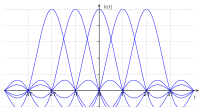
Photo from wikipedia
Abstract In the current passive optical networks (PONs), we address the challenge of dealing with asymmetric channel conditions and asymmetric data rates in order to meet the traffic demand of… Click to show full abstract
Abstract In the current passive optical networks (PONs), we address the challenge of dealing with asymmetric channel conditions and asymmetric data rates in order to meet the traffic demand of optical network unit (ONU) to ONU (O2O) communications. A joint network-coding (NC) and power domain non-orthogonal multiple access (NOMA) approach (NC-NOMA) is discussed. The novelty of this NC-NOMA scheme lies in the way the inter-ONUs communicates with an optical line terminal (OLT) at different modulation formats. Specifically, in the uplink communications, at each ONU side, multiple data streams from different ONUs are superimposed into one single symbol. Meanwhile, NOMA is considered by adjusting the optical transmission power of ONUs such that the OLT can decode the signals from different ONUs based on successive interference cancellation (SIC). At the OLT side, the adding zeros approach at the specific positions of the shorter bit sequence is introduced. In the downlink communications, the ONUs obtain their own data by decoding the received messages. By applying NC-NOMA, the ONU with better channel condition only needs to demodulate the fictitious symbols with a low order modulation format instead of demodulating the symbols with a high order modulation format. The simulation results show NC-NOMA with hierarchical adding zeros approach outperforms NC-NOMA with traditional zero padding approach in terms of having lower average end-to-end BER of ONUs without having additional complexity.
Journal Title: Optics Communications
Year Published: 2020
Link to full text (if available)
Share on Social Media: Sign Up to like & get
recommendations!